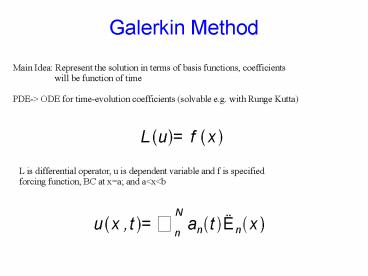Galerkin Method - PowerPoint PPT Presentation
1 / 35
Title:
Galerkin Method
Description:
L is differential operator, u is dependent variable and f is specified ... Rubbish. Numerical instability has to be avoided; but how???? Von Neumann stability ... – PowerPoint PPT presentation
Number of Views:900
Avg rating:3.0/5.0
Title: Galerkin Method
1
Galerkin Method
Main Idea Represent the solution in terms of
basis functions, coefficients
will be function of time PDE-gt ODE for
time-evolution coefficients (solvable e.g. with
Runge Kutta)
L is differential operator, u is dependent
variable and f is specified forcing function, BC
at xa and altxltb
2
Galerkin Method
Error
Choose an(t) such that eN is orthogonal to each
basis function
3
Galerkin Method
The above N algebraic equations can be used to
solve the N unknown coefficients a(t)
Spectral method
Finite element method
4
Galerkin Method Example again diffusion equation
Time-discretization
5
Galerkin Method Example again diffusion equation
Approximate
Example K1, n10, ?t0.1
Sign alternating solution Rubbish
Approximate
Exact
Numerical instability has to be avoided but
how????
6
Von Neumann stability
A solution to a linear equation can be expressed
in terms of a Fourier series, where each harmonic
solution is also a solution We can test the
stability of a single harmonic solution
stability of all harmonics can then be a
necessary conditions for stability of the
scheme assume at some time (t0) that 1.) A
Fourier expansition of the initial field f(x) can
be made 2.) A separation of time and space
variables can be made, such that at time t a
simple term in the Fourier series is
7
Von Neumann stability
Ensures numerical stability
4. Requiring
Is required physically
5. Oftentimes
Example 1-d diffusion equation, again and again
and again
Assume forward differencing in time and finite
differencing in space
8
Von Neumann stability
9
Solving partial differential equations
Hyperbolic wave equation Initial value (Cauchy)
problem
parabolic diffusion equation Initial value
problem
elliptic Poisson equation Boundary value problem
From a numerical point of this distinction is not
too important
10
Solving PDEs
Initial value problem, defined by the anwers to
the following questions - What are the dependent
variables to be propagated in time? - What is the
time-evolution equation for each variable? - What
is the highest time derivative for each
variable? - What boundary conditions govern the
evolution in time? (e.g. Dirichlet Bcs
boundary values as function of time, Neumann
conditions specify normal gradient at the
boundary - Most crucial aspect is the stability
of the numerical scheme!!!
Boundary value problem, defined by the anwers to
the following questions - What are the
variables? - What equations are satisfied in the
interior of the domain? - What equations are
satisfied by points on the boundary region of
interest? - Most schemes are pretty stable - BC
must be satisifed simultanously -gt linear matrix
equations
11
Example 1-d wave equation
Characteristics is location of constant phase in
x-t continuum
Dispersion-free movement of initial
wave-package Initial value problem, perturbation
moving to the left
12
Example 1-d wave equation
Search for equation whose solution can propagate
both to the left and right
Classical wave equation
With
Solution of
13
Example 1-d wave equation
Traveling wave moving to positive x (to the
right) Characteristics tx/c
Discretization xm?x, m0,1,2,.....
tn?t, m0,1,2,..... u(x,t)
u(m?x,n?t)umn Using forward differences in
time and centered in space (FTCS)
14
Example 1-d wave equation Stability
P
Unconditionally unstable scheme
15
Example 1-d wave equation Stability of FCTS
FTCS
16
Example 1-d wave equation
Discretization xm?x, m0,1,2,.....
tn?t, m0,1,2,..... u(x,t)
u(m?x,n?t)Cmn Using centered differences
in time and space CTCS
17
Example 1 d wave equation
Called leap-frog scheme, doesn't work for the
first two time steps use Euler forward (forward
in time, centered in space, FTCS) for first two
steps
T
N1
N
N-1
M
X
18
Example 1 d wave equation
19
Example 1 d wave equation
Stable scheme
If
If
Unstable scheme
20
Example 1 d wave equation
For any k, stable scheme
Courant-Friedrichs-Lewy (CFL) stability criterion
21
Example 1 d wave equation
CTCS
22
Example 1 d wave equation
Mathematic problems with CTCS computational
dispersion and parasitic waves Physical problem
with CTCS negative values, bad for concentration
23
CFL criterion
T
Means no amplitude loss But phase error
possible gt computational dispersion
Unstable
Stable
Stable
1/c
X
High velocities means small time-steps Characteri
stics of true equation have to lie within cone
of influence of CTCS scheme
24
CFL criterion
25
Example 1 d wave equation
Using uncentered differences in time and space
UCTCS
Unstable
Stable, but damping of amplitude
26
Example 1 d wave equation
UCTCS
27
Numerical diffusion in Euler backward scheme
28
Numerical diffusion in Euler backward scheme
Numerical diffusion enters the advection equation
with equ. Diffusion coefficient
29
Numerical dispersion
Solution
Provided that
Frequency fkc or cf/k is phase speed of
waves Waves with all wavelengths are propagated
with same speed gt no change in shape at a
constant velocity along x-axis
30
Numerical dispersion
Hyrbid of differential and finite difference
equation semi-discrete equation
Solution
Provided that
Phase-speed dependent on k gt Dispersion of waves
31
Numerical dispersion
Small klarge wavelength gt large wave
speed large k small wavelength gtwave speed goes
to zero
Check numerical scheme prior to any application
for numerical dispersion and diffusion!!!
32
Summary of schemes
FTCS scheme
Unconditionally unstable diffusion coeff. Negative
Leapfrog scheme
Parasitic waves negative concentrations
UCTS scheme
33
Summary of schemes
Matsuno scheme too diffusive no computational
mode
Lax-Wendroff scheme no computational mode,
damping of high freq, waves
34
Summary of important concepts
- Galerkin approximation
- Von Neumann Stability criterion
- CFL criterion
- Numerical diffusion, bad for amplitude
- Numerical dispersion, bad for phase
35
Term projects
Francois Jets in a nonlinear eddy-resolving
shallow-water model Thomas West-Antarctic
ice-sheet collapse, sea level rise Denise
Drake passage closure in BARBIE model Pierre
Bifurcation analysis Laurie Ice-sheet model































